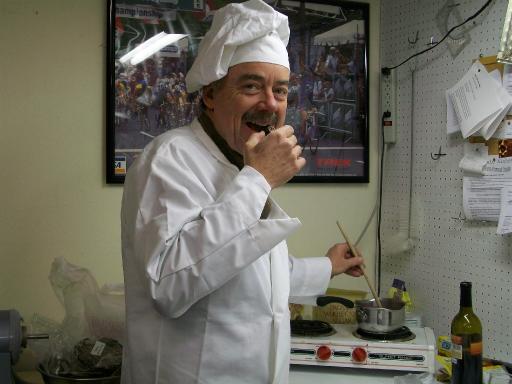
Recently Rated:
Untitled
Now Try This: #4 (a) Franks Famous Chopped EspressoA friend and I have been experimenting with coffee beans in molded chocolate. Weve tried dark chocolate and dark milk chocolate shells; bite-sized molds and slightly larger molds ; one bean and two. So far, theyve not been flavored with anything else, just the coffee bean. And these are not confections coated with a hard sugar shell on the outside like some of the chocolate covered coffee beans or M&Ms. Nothing seemed to satisfy his desire for really intense coffee flavor; Ill admit, the chocolate having been roasted from the bean in my workshop is pretty powerful and so may have dominated the coffee inside.We came up with a solution; maybe two, that seems to solve the desire for really powerful espresso flavors in molded chocolate. Now this is off subject for Mr. WineCandy. For me its supposed to be all about spirituous jellies and ganaches inside molded from-the-bean confections. But, these coffee experiments have come out quite well and I thought I ought to share the unusual solutions.The objective here is not just to get a strong espresso flavor inside the chocolate for my friend, Keith (who has travelled the world, retired now, British Navy ; he has lots of experience savoring strong flavored foods) but also to get the crunch which is such an important part of the coffee bean /chocolate encounter. We dont want to do away with the bean, nor do we want to make it soggy or chewy inside the shell.Heres what I did to make the desired flavors and mouth feel. As you might have guessed; to get more coffee flavor, chop the beans into large pieces to more completely fill the shell. As you might not have known, cover the chopped coffee beans immediately after roasting them. And just as important to the flavor intensity, and what you really want; preserve the unique flavor of those unique coffee beans by not over-roasting them. You may have thought you wanted dark roasted beans to get the most intense espresso flavors, not so. These are oils in the coffee beans that we are dealing with, which carry the flavors. We dont want to burn off these flavor oils by over-roasting the beans.

I meant to note the beverage in the backround of the photos is not coffee. It is , of course, Guinness Extra Stout. Most necessary in the coffee roasting process. Note that there is less of it in the glass in the photo where the coffee beans are finished roasting.